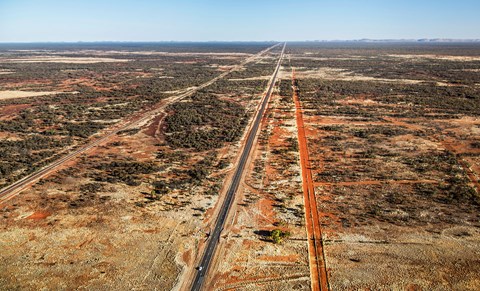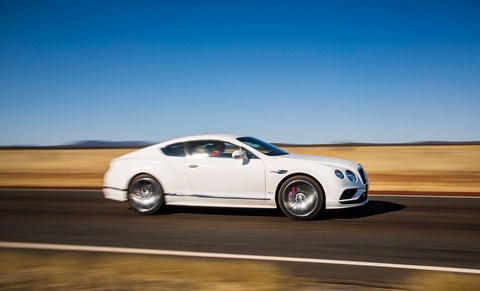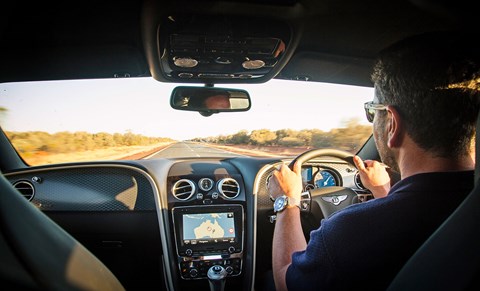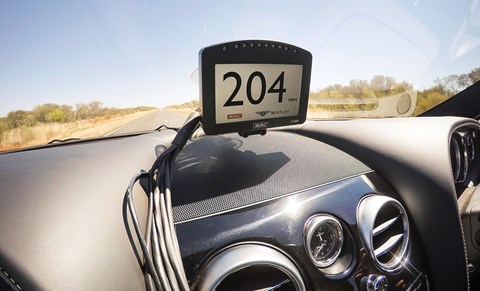► Bentley Continental Speed vs the Australian outback
► An Antipodean adventure drive in Bentley’s fastest
► Can we hit 200mph legally in the latest Conti?
As the Bentley closes on 200mph its handmade and leather-swathed cabin seems to fade out of my awareness, and instead I zero in on the Continental GT’s fundamentals until it feels race-car basic. I remain very aware of the steering wheel. The two-lane black-top stretching out ahead of me – not autobahn, not test track, just an ordinary public road – might be laser-straight and flat but the surface ain’t level. Above 180mph each dip and pothole causes the wheel to kick back and the car to drift a foot or two to either side. Nerves make me want to strangle the rim and it is a conscious effort to keep my grip loose. The constant, precise corrections required are small, but a lot bigger than I’d like to be making at this speed.
I am also very aware of the throttle, which requires conscious effort to simply hold wide open. The noise and the sensation through my backside tell me that the 626bhp six-litre W12 is finally starting to labour so I must be getting close to 206mph, or whatever the Bentley’s maximum speed is in these conditions. Up to 180mph, I have to force myself not to follow my progress on the dials. Above 180mph, I have no desire to. My gaze is fixed out through the bug-flecked screen. But although I ought to be able to see the three miles to the horizon, there’s a solid heat-haze reflecting the sky onto all but the first 200 metres of road, so it looks like I’m constantly approaching a crest. The helicopter overhead tells me the road is clear, but my right foot would like visual confirmation.
And I keep thinking about the brake pedal, because I would very much like to use it. It’s a couple of inches and three long seconds away: at this speed you need to act quickly but never suddenly, and I’m already planning how I’ll oh-so-gently roll off the gas and squeeze that brake when one of us – me or the car – finally runs out of heart.

Travelling at 200mph is unnatural. Nature never intended us to travel faster than a horse’s gallop, but we’ve become used to travelling quickly in cars. In aircraft and bullet trains we travel faster still, but are isolated from the experience and seldom in control of it. There are now plenty of cars that allow you to send yourself across the face of the earth at 200mph, but very few places on earth where you actually can. The autobahns are usually too congested to do it safely in daylight hours. There are only a handful of test tracks at which you might sustain that speed, and they’re not open to the public. The opportunity is so rare and the experience so fleeting that you never get used to it. 200mph is very odd: very different even to 180mph. You still feel like you’re transgressing the laws of nature.
But I am not breaking the law of the land. Australia’s Northern Territory is unlike any other place on earth for many reasons, but for us it’s notable mostly for its attitude to speed. Until 2007 it had no speed limits on most of its two-lane highways. Vast stretches weren’t even policed. This would be astonishing anywhere, but it was particularly odd that an absence of limit should persist in Australia, which elsewhere has a mono-maniacal focus on speed as the cause of road accidents, and enforces its low speed limits with severity. It wasn’t surprising when Northern Territory gave in and imposed a blanket 130kph (80mph) limit in 2007.
But it is extraordinary that last year the new right-wing Country Liberal administration (they sound like fun) made good on an election pledge to lift the limit again on two trial stretches of the Stuart Highway, which runs straight up through the Territory to the capital Darwin on the coast. In doing so, Northern Territory has extended both middle fingers to the global trend towards lower speed limits, greater regulation, reduced responsibility for the driver, and eventually autonomous driving. The percentage of the autobahn network which is derestricted is shrinking and opinion polls and party policies in Germany increasingly back a blanket speed limit. Northern Territory is the only place in the world which has turned against the tide.

I am no Clarkson. Greater regulation is inevitable and not always a bad thing, and the world’s roads are getting safer. But I wanted to sample this freedom while it lasts. I wanted to see how it feels to be given the responsibility to drive on ordinary roads at whatever speed seems appropriate, and to be able to drive without the fear of a legal tap on the shoulder if my speed inadvertently drifts up by a few kays to something still safe, but illegal. I wanted to ask the locals and the police what they thought about the ‘open’ limit, and what speed they choose to drive at. I wanted to find out why this is happening in Northern Territory, and nowhere else. And I wanted to mark this moment, this last hurrah for speed and personal responsibility, with a really big number.
I found one reason why this is happening in NT and nowhere else before I’d even landed. Foreigners often don’t get that Australia is a coastal country. You can fly for hours across the Outback and from the cloudless opal sky you won’t see a single human mark on the red earth as it unrolls endlessly beneath you. Northern Territory has a lower population density than any country and any major land mass bar Greenland and Antarctica. It is six times bigger than the UK, and has about as many inhabitants as Luton. Even at 200mph you’ll struggle to find anyone to hit.
Having collected the Bentley Continental GT Speed in Alice and scarfed the finest burger I’ll ever eat in Monty’s, I headed north up the Stuart to the start of the open-limit zone. A map is not required.
Why a Bentley? Honestly, mostly because Bentley said yes where other car makers declined. Ask to have a 200mph car delivered to Alice Springs (or to borrow one in Australia for a long time and to put a big mileage on it) and it’s obvious what you’re going to do. But Porsche tested the 918 here after the limit was lifted and made a short online film about it. Bentley was planning to do the same, and offered me the use of the car: after its film was safely in the digital can.

But there’s good reason for doing it in this car, name aside. The Speed is the fastest road car Bentley has ever made. If you plan to do a genuine 200mph in the uncontrolled conditions of a public road you need a car that can do comfortably more, and even the Speed’s claimed 206mph offers a smaller margin than I’d like. But ‘the world’s fastest lorry’, as Ettore Bugatti called Bentleys, is a better car for the circumstances than a hard-riding, fragile Italian. Its all-wheel drive and air springs have long offered supercar performance with all-condition usability: this is the secret of an 11-year success which has been transformational for its brand. The Continental has always been engineered to do 200mph even if it seldom will, and the weight penalty that brings caused many of our criticisms of the car. The lighter, more agile V8 is our preference now, but if you want to do 200mph you need the full-fat W12. It’s good to finally drive this car as it was engineered to be driven.
A few kilometres north of Alice Springs, as we cross the Tropic of Capricorn, I find what I’ve come for: the diagonal black stripe through a white circle that indicates the end of speed restriction, and the three words that every enthusiastic but responsible driver in the UK wishes we could see on our roads, but never will: ‘Drive to conditions’. This isn’t a free-for-all: you can still be jailed for six months for driving ‘carelessly, recklessly or at a speed or in a manner that is dangerous to the public’, according to the new Northern Territory Traffic Regulations, which I made sure to read.
So what speed did the conditions suggest? Certainly not 200mph for the entire trip. In this almost unique circumstance you can let your car run out to a speed where its capabilities and the road and the weather and your skill find a natural, comfortable balance. In the Bentley, that turned out to be between 140 and 150mph, or nearly double the old limit. Here the Bentley feels utterly within its capabilities; the steering calm, the braking more than sufficient and the cabin as calm as an ordinary car’s at 80mph.

There is the occasional bend but they’re well signposted, and in a handful of places there’s a speed limit through a junction or a tiny settlement. But mostly the road just runs Marlboro-straight across the flat red dirt, flanked by patchy bleached grass and low, sage-coloured bushes. There’s little to measure your progress against, other than the wedge-tailed eagles wheeling overhead. The ‘traffic’ is mostly road-trains, farm utes and foreign backpackers in crappy vans, and you can go for minutes without seeing another vehicle. The speed keeps me alert and I don’t feel like I’m endangering myself or anyone else. At this rate, and if the open limit extended all the way, I could have breakfast in Alice and lunch in Darwin, and the Continental would cover half a continent in half a day. I’d like to come back and try.
It’s not hard to see the benefit forTerritorians who have to make this 1000-mile trip regularly, and for whom even a 100mph cruise might cut two tired hours from a 12-hour trip. I wanted to ask them how they used their freedom, but first I had to find one. There is only one-fifth of a person per square kilometre in Northern Territory (there are 255 in the UK), so beyond Alice and Darwin, it’s lonely. We stopped at Ti Tree, a roadhouse about 200km north of Alice. Inexplicably, its claim to be Australia’s most central pub wasn’t attracting many customers. The few people who had stopped were mostly those backpackers. The three staff running the shop and bar were in their early twenties and from the UK. Did they see many fast cars filling up here, taking advantage of the open speed limits? ‘Not really. I think we saw a Lamborghini once.’
Outside I bumped into two local policemen. Unprompted, and not speaking officially, they confirmed the one survey which the Country Liberals have released, which recorded accidents and average speeds over the derestricted stretch over its first year. There were 11 accidents, of which only one involved a serious injury, and that was due to drug use and not wearing a seat belt. Most interestingly, the speed Territorians choose to drive at when you give them a free choice is, on average, between 133 and 139kph: barely more than the old speed limit.
One officer repeated what almost every other Territorian had told me: that few people up here have cars that can do much more than 130kph, and that for almost everyone, a reluctance to burn more gas outweighed the temptation to go fast and get there sooner. He also confirmed that almost nobody comes to the Stuart Highway to engage in ‘hooning’: unless you live here, it’s just too far away. This might disappoint the Country Liberals, who want to present Northern Territory as a petrolhead paradise and win back the car makers who once tested here, drawn by the high temperatures and sustained high-speed running.

But what is it about Territorians that makes them support the open limits, when the rest of Australia is so obsessed with health and safety? Not all of them do: some that I spoke to just saw it as a right-wing, libertarian stunt. ‘I think there’s a sense of liking to be a little bit different in the Territory,’ says Transport Minister Peter Chandler. ‘I think the average Territorian doesn’t much like the South, and doesn’t like much being told what to do. We are a little bit different. I see this as just giving back a right that we once had.’
One last question to answer. What will the Bentley do when you take the speed limit off a road no better or wider (though a lot straighter) than a single-carriageway British A-road? Australian racing legend John Bowe is in the passenger seat, watching the big GPS speed display stuck to the screen, working the stopwatch and spotting ’roos. He drove the car down the same stretch for the film yesterday, and says it’s fine, but rough at the far end. Two local TV news crews have come out to report on us. The cops know what we’re doing, and are cool with it, so long as we hold the traffic at the far end of our 13km stretch. It’s so light that we rarely inconvenience more than three cars, and at flat-chat it doesn’t take the Bentley long to get to the other end, and let them pass.
The run doesn’t require much more than checking the Bentley’s tyre pressures, switching off the air-con, putting the dampers into their firmest setting and the gearbox into Sport, which locks out eighth gear. Once the chopper has confirmed all is clear, I just mash the throttle. After just three miles and a minute and sixteen seconds we’ve hit 200mph, and I press on to see how much faster the Bentley will go. Another five miles can only add 4mph to the display. In gusting wind, and with the Bentley’s steering kicking back furiously and its fine ride quality disintegrated, this feels quite fast enough. 204.5mph, on a two-lane public road. But for how long?

The politics of no limits
Northern Territory’s speed policy is hugely controversial. ‘They’ll have blood on their hands,’ says Harold Scruby, chief executive of the Pedestrian Council of Australia. The Territory’s former road safety expert calls the limit-free stretch ‘a political exercise’ rather than ‘an evidence-based decision’. He points out that you can’t compare ‘an undivided rural two-lane road with no passing lanes, no median barriers, unsealed shoulders, and subject to desert conditions’ to ‘first-world’ roads like the autobahns. The Country Liberals, the body behind the lifting of the limit, said they had four studies supporting the move, but declared them confidential. Even the local motoring and police associations have opposed the policy.
The Country Liberals plan to extend the trial to most of their highways, but Transport Minister Peter Chandler admits their freedom might not last: ‘Northern Territory only exists through a piece of federal legislation, so at any time the federal government could shut us down.’
The specs: Bentley Continental GT Speed
Price: £168,300
Engine: 5998cc 48v W12, 626bhp @ 6000rpm, 605lb ft @ 1700rpm
Transmission: 8-speed dual-clutch, four-wheel drive
Performance: 4.2sec 0-62mph, 206mph, 19.5mpg, 338g/km CO2
Suspension: Multilink front and rear, adaptive dampers
Length/width/height: 4806/ 1944/1394mm
Weight/made from: 2320kg/steel and aluminium
Fuel tank: 90 litres
Rating: *****
